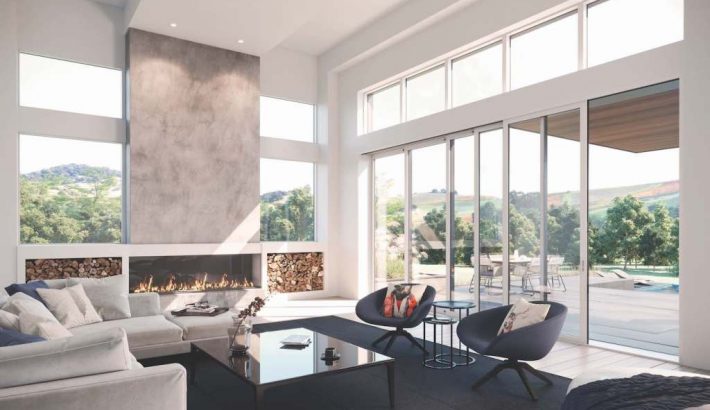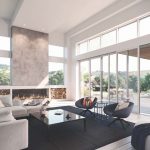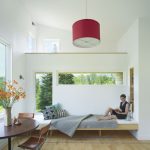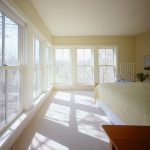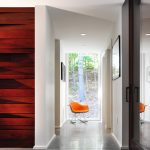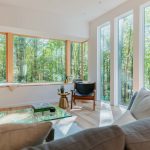How harnessing light can lead to happier and healthier homes
Today, people are looking for ways to live healthier and happier, and they expect their homes to be part of that quest. We often look to designers and architects to help create positive home environments, and these experts are increasingly considering light as an important tool to boost happiness.
Research indicates that increased exposure to light makes people more productive and improves their sense of well-being, therefore improving overall wellness. [1] It’s no surprise, then, that homeowners and architects alike are exploring ways to bring more natural light into homes.
Biophilic design: a return to evolutionary psychology
To understand the impact of light in a home, it helps to explore the concept of biophilic design. Biophilic design incorporates evolutionary psychology in the design of spaces. We’ve always sought certain elements to feel safe, secure, and in the most optimal emotional state; ingrained in us from the earliest days of days of living on terrain like meadows and the savanna. [2]
Gazing outside inspires a direct connection to the healthy, natural state that people experienced when they spent most of their time outdoors. “The feeling of being in nature stays with you, even while inside looking at trees, a garden, or patio,” said Manny Gonzalez, FAIA, LEED AP, principal and board of directors at KTGY, a Los Angeles-based architecture firm.
“Your mind may not realize it, but your body wants that feeling of getting back to nature.”
Manny Gonzalez, FAIA, LEED AP
Exposure to light makes us feel better
The concept of biophilia comes to life when we consider the body’s response to daylight. Daylight affects the health of our circadian rhythms, also known as our internal sleep/wake cycle. (3) These rhythms are primarily regulated by light and darkness in an environment and are recognized by a third type of receptor in our eyes. [4]
The same idea is at work in our homes. The more exposure to the outdoors and light, the better we feel. “All of these things tie into healthy living, the ability to get the sleep that you need, the wellness everyone is trying to get,” said Gonzalez.
“Sunshine suits”
Conversely, research has shown that a lack of exposure to light can actually make us sick, and some countries have already begun addressing their citizens’ right to light. In Japan, skyscrapers and intense urban density led to the concept of “nissho-ken,” which translates to “a right to sunlight.” After a string of “sunshine suits,” more than 300 Japanese cities adopted “sunshine hour codes,” specifying penalties that developers must pay for casting shadows.
The Japanese were early to realize the impact of sunlight on health and happiness, crucial when you consider that we spend up to 97% of our time indoors.[5] All the more reason to bring light into the home, since we may not get outside much to experience it.
Light considerations in design
What exactly does it mean to design around natural light? “Being able to control the lighting, whether it’s the natural light that you have, the UV rays that you get through a window, visibility, and window coverings—all those things start tying together when you’re creating the proper environment,” said Gonzalez.
Window styles, configurations, and glazing can all work together to create a functional, healthy, and inspiring light-filled home. Architects also take siting into account—understanding the land and placing windows for maximum natural light. Choosing a design style that prioritizes large expanses of glass and unobstructed views, like in Marvin’s new Modern product line can also offer the opportunity to design with light as a focal point.
Modern homes tend to have more windows and narrower frames, increasing the capacity for light to pass through and offering better views. When Marvin created its new Modern product line, it offered homeowners an opportunity to embrace the principles of modern design, a concept that is closely intertwined with exposure to light.
“Our goal was to create a designed experience that offers minimal sightlines and large expanses of glass, providing seamless, clutter-free visuals that make engaging with the outside world easy. This enables homeowners to achieve what they seek in their home—connection, restoration, and freeness.”
Christine Marvin, Director of Corporate Strategy + Design
Explore the Modern Product Line
Emotional and physical benefits
When a home’s design embraces and enhances the benefits of natural sunlight through deliberate choices that strengthen our connection to the outdoors, those much-desired feelings of well-being are a natural result.
“If you do a good job as an architect, the resident won’t even know that they’re experiencing biophilic design,” said Gonzalez. “They don’t even think about it—it just feels good.”
[1] NeoCon June 2018 seminar: “Applying Wellness Principles to Residential Construction”
[2] “The Economics of Biophilia,” Bill Browning, Terrapin Bright Green
[3] “Your Body’s Internal Clock And How It Affects Your Overall Health,” The Atlantic, March 2012
[4] National Institute of General Medical Sciences: Circadian Rhythms
[5] NeoCon June 2018 seminar: “Applying Wellness Principles to Residential Construction”

